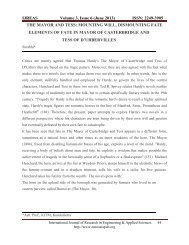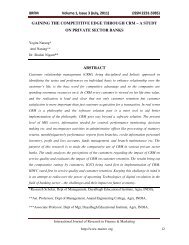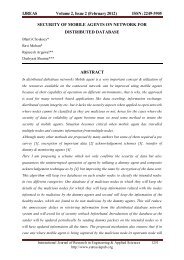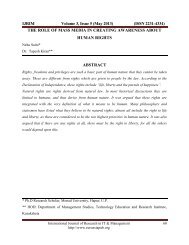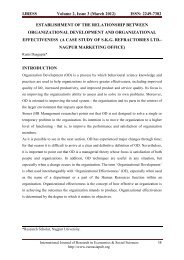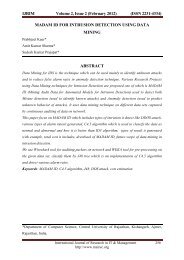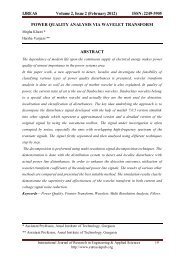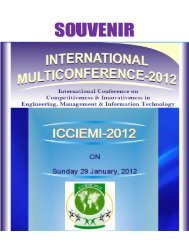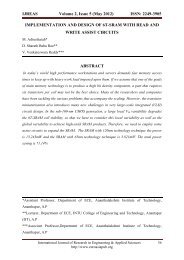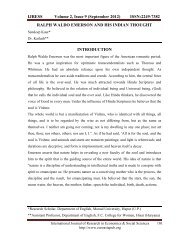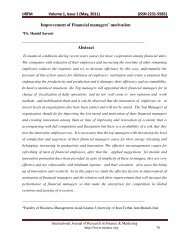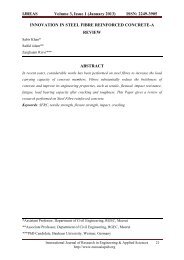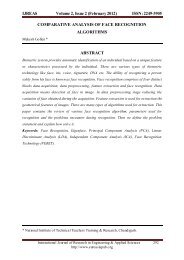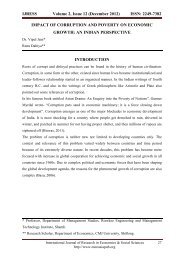ANALYSIS OF THE FACTORS INFLUENCING ... - Euroasiapub.org
ANALYSIS OF THE FACTORS INFLUENCING ... - Euroasiapub.org
ANALYSIS OF THE FACTORS INFLUENCING ... - Euroasiapub.org
You also want an ePaper? Increase the reach of your titles
YUMPU automatically turns print PDFs into web optimized ePapers that Google loves.
IJRIM Volume 3, Issue 5 (May 2013) (ISSN 2231-4334)<strong>ANALYSIS</strong> <strong>OF</strong> <strong>THE</strong> <strong>FACTORS</strong> <strong>INFLUENCING</strong> <strong>THE</strong> CAREERCHOICE <strong>OF</strong> UNDERGRADUATE IIT STUDENTS USING AHPShriya Sukalikar *Abhinav Kumar Singh *ABSTRACTChoosing the right career is one of the most critical decisions in a student’s life. Variousaspects condition the decision of a student. This paper attempts to analyse the factors thataffect the career choices of undergraduate engineering students. The possible factors shapingthe choice of students are listed based on previous studies and judgements made by experts.The final- and pre-final-year students from Indian Institute of Technology, Roorkee,India, aresurveyed. The survey finds the most dominating career preference among the students to bein the Information Technology and Management sector. Using analytical hierarchy process,the relative weights of the various factors affecting this trend are found. It is observed thatfor a majority of students, personal aptitude, growth prospects, and future income are themost dominating factors in the decision-making process. The job-training process isconsidered least important; long gestation periods or the need to pursue furtherspecialisation are acceptable as long as more important factors like personal aptitude,growth prospects, and future income are favourable in that career option.Key-words:Analytical Hierarchy Process, Career Choice, Engineering Students,Undergraduate Students* Indian Institute of Technology RoorkeeInternational Journal of Research in IT & Management 66http://www.euroasiapub.<strong>org</strong>
IJRIM Volume 3, Issue 5 (May 2013) (ISSN 2231-4334)INTRODUCTIONWith advancements in technology and shrinking of the world into a global village, careeropportunities have expanded manifold. Students have a vast choice of career fields, and newfields are securing their place in the list. Different opportunities have paved their way forstudents at the graduation level. In such a scenario, students need to make a well-rounded andinformed choice.The availability of myriad options has resulted in a slow but promising shift of trend.Students have begun to pick unconventional careers. Engineering students are increasinglyexposing themselves to non-technical and creative fields.However, the factors on which final career choices are madecan be multifaceted andcomplex. Through research, it has been found that the major criteria that dominate the finaldecision patterns of the careers of engineering students are personal aptitude, societalexpectations, growth prospects, specialisation requirements, future income, prestige of worketc. The degree of importance of each criterion is a subject matter of every individual’schoice, environment, and conditions.This paper aims to conduct a survey of engineering graduates and understand factorsaffecting their career selection after their technical degree, considering the various aspectsthat condition their final choice. Ultimately through Analytical Hierarchy Process (AHP), thispaper aims to determine the weighted order of the different career alternatives in order tojudge the recent trend of fields chosen by engineering students and their inclinations towardsvarious deciding factors.LITERATURE REVIEWExtensive studies have been conducted in the field of career-selection criteria and theirrelative importance, as regarded by undergraduate students while deciding their careers aftercompleting graduation (Lim and Soon, 2006). Previous research papers have reached varyingresults, as far as the degree of importance of the career-selection criteria are concerned.The research by Ginsberg et al.(1951) and Super(1957) suggests that the choice of occupationis affected by personal choices, such as value system, aim, and personal ability as well associetal strata and structure, thereby constricting the gamut of careers which an individual canpursue. High income is observed as the most important criterion in the research of Bai(1998). However, Lau and Pang (1995) suggest that a person’s ability can be validated by theamount of salary he or she receives. The opportunity for advancement is found to be of theprimary importance in career selection by many research studies and literature (Moy and Lee,International Journal of Research in IT & Management 67http://www.euroasiapub.<strong>org</strong>
IJRIM Volume 3, Issue 5 (May 2013) (ISSN 2231-4334)2002; Boswell et al., 2003;Wilkinson, 1996). On the other hand, training and examinationassistance are the important factors according to Chan and Simon (2000). Stephen A. Butleret al.(2000) have found that growth prospects and work stability aregiven the highest weightage by students. A study by Kyriacou et al. (2002) reveals that the choices made are mouldedby the available career paths and the opportunities for growth in them. Özkale et al. (2004)surveyed around 400 undergraduate students to find that the most highly weighted factorsaffecting their choices are their interest in their career fields, their desire to be leaders, andtheir performance in the university’s entrance exams. Zedeck (1977) analysed that theopportunities for growth, salary, flexible nature of work, and the duration of the project,respectively are the important criteria in descending order. Heneman, Rynes, and Schwab(1983) project the importance of pay scale and its variability in the market for job-relatedchoices. In the study, it is found that salary is the chief determinant of the job appeal. It isalso revealed that the higher the variability of salary, the more is the weight age of salary inthe process of choosing the career. Feldman and Arnold (1978)demonstrate that compared towork characteristics such as flexible work hours, the opportunity to practice and demonstrateone’s skill sets, non-pecuniary benefits, and independence, the pay holds much higherinfluence on one’s decision-making process.A study by Aycan and Pasa (2003) examines the variation in the students’ career choices as aconsequence of their cultures and backgrounds. Though the room for growth and pay scaleare commonly the pressing criteria, every study has generated unique results. For example,Phillips et al. (1994) and Karl and Sutton (1998) rank “job security” as the highest-but-oneweighted criteria, while Moy and Lee (2002), rank it highest-but-two. Work location andconditions are identified as important criteria in the research of both Wilkinson (1996)andBoswell et al. (2003). Another research conducted by Hüseyin SelçukKılıç and EmreÇevikcan (2011) concludes that “loving the job” is the highest weighted criterion by facultyand male and female students. Ming Lu (2012) concludes that for college students choosingtheir future careers, the most important factor is the development prospects followed by theworking conditions. Ethington Feldman, and Smart (2000) use the “theory ofcareers”(Holland, 1966; 1985),to find that a milieu resonating with the students’ personal isan appealing factor in their choice making.Chan and Simon(2000) suggest that demographic factors like gender are also key factors inthe criteria selection process. Aytaç and Bayram (2001) reveal that even though the orderingof the factors is alike for both genders, the corresponding weights of the factors, which areInternational Journal of Research in IT & Management 68http://www.euroasiapub.<strong>org</strong>
IJRIM Volume 3, Issue 5 (May 2013) (ISSN 2231-4334)indicative of the degree of their importance, are different formales and females.However,Özkale et al. (2004) indicate reasonable variation in the choices of males andfemales. Females are influenced by inspiring figures of any gender while males are primarilyinspired only by idolised, dynamic, and influential males. Brainard and Carlin (1998) discussthe impact of society, family, and family relatives on the engineering choices of students ofeither gender. They note that females are affected more by their peers and relatives ascompared to their male counterparts. Similar results have been obtained in context of a fewother nations (Brainard and Carlin, 1998).AHP ProcessThe complexity of choosing a career may not be detangled by perspicacity, exposure, orintuition. The variety of criteria shaping the final decision can be overwhelming and, often,self-contradicting. What worsens the situation further is that not only is the interdependenceof the criteria confusing but the proposed solutions can also be contradicting.The AHP, proposed by Saaty (1977; 1980; 1982;2008), is a tool for analysing complex,multi-criteria problems and reaching a strategic decision. In this method, the analyser forms atree-like hierarchy to analyse the complex issue and then rates each branch and leaf node atevery strata of the tree. To illustrate using an example, a typical hierarchy will have at leastthree levels: (a) the goal to be achieved, (b) the criteria involved, and(c) the alternativechoices.AHP technique does a pair wise analysis of the relative importance of all criteria to form apair wise comparison matrix and find a scale to compare the relative dependence andimportance of the criteria. These pairwise comparisons also establish the impact measure ofthe sub-criteria in the upper strata of the tree upon the next lower strata, thereby establishinga relationship among the various levels of the hierarchy. After this, eigen vectors arecalculated for every criteria. Dr.Saaty(1990) has demonstrated through mathematical resultsthat finding eigen vectors is the best way to solve the problem.Multiplication of the individual weights of all the nodes of a branch from the root to the leaf,will give the final priority of the leaf, that is, the criteria. This is iteratively done till the finalpriorities of all the alternatives have been calculated. The consistency ratios are calculated forthe questionnaire results to confirm the validity of the results of the pair wise analysis of thealternatives.METHODSubjectsInternational Journal of Research in IT & Management 69http://www.euroasiapub.<strong>org</strong>
IJRIM Volume 3, Issue 5 (May 2013) (ISSN 2231-4334)In 2013, this study surveyed pre-final and final-year students of Indian Institute ofTechnology, Roorkee, India, regarding the dominant trend in choosing their careers and thefactors affecting the choices made. The questionnaire was distributed among two hundredstudents undertaking their third and fourth year of study.Analytic Hierarchy Process (AHP)In 1970, Saaty, expounded the AHP technique as a measure for making cogent judgementsand reaching an informed solution from varied judgements. In this study, students assignedtheir own values (judgements) after comparing among a set of criteria. The mean of all thevalues assigned by students depicts their preferences and notions on the given criteria. Thecourse followed for establishing an AHP model was as follows:Step 1: The problem was decomposed into a hierarchy of complementary factors in order tosetup a hierarchy system. In this study, based on a literature review, the hierarchy system wasestablished and later modified according to the opinions of experienced professors and threepreliminary surveys.Step 2:A pair wise comparison matrix was generated in order to calculate the relative weightage among the given criteria involved.Step 3:The opinions of each student were synthesized and comparative weights wereestimated.Step 4: Average relative weights of the criteria were determined in order to generate apreference order for the various alternatives. Principal eigen vector of the pair wisecomparison matrix was used by Saaty to calculate the relative weight age among theattributes of the tree structure. To compare ‘n’ attributes pair wise as per their relative weightage, represent the attributes by a 1 ,a 2 ,...,a n and their corresponding weights by W 1 ,W 2 ,...,W n .Let, W = (W 1 ,W 2 ,...,W n ) T , the pair wise analysis may be shown by matrix Masfollows λmaxIW 0 aIn Equation (a) M= positive reciprocal matrix of comparison. Eigenvector W with respectiveλ max must be calculated to find out the priority eigen vector. λ max must satisfy MW=λ max W.Consistency Index was suggested by Saaty to test the consistency of innate judgement.Generally, the Consistency Index with the value less than or equal to 0.1 is tolerable. λmax – n/n 1Designing the AHP questionnaireIn order to establish the important factors affecting students’ choice of a career, the study firstreviewed the aforementioned literature dealing with a similar research goal. The tiers of theInternational Journal of Research in IT & Management 70http://www.euroasiapub.<strong>org</strong>
IJRIM Volume 3, Issue 5 (May 2013) (ISSN 2231-4334)AHP questionnaire were then constructed using these factors. This was followed by the useof Delphi Technique by consulting a group of ten final-year students from assorteddepartments to review and modify the questionnaire.The first tier gauged the three aspects of Personal Priority, Job Training Process, and WorkCharacteristics. The second tier gauged leading eleven criteria: personalintelligence/aptitude, influence of role model, opportunity to establish an independent setup,future income, growth prospects, prestige of job, contacts in the field, related internship andprojects, gestation period, societal and family expectations, and speciality requirements. Theglossary consists of the description of these criteria. Students were first made to choose theircareer choice out of the nine fields given in the third tier.The AHP Consistency Test proposed by Saaty was applied to analyse data integrity, and thequestionnaires succeeding in the consistency test were considered valid. The questionnaire’sefficacy was also validated by a number of senior professors.RESULTSA total of 188 questionnaires were returned out of which 180 were conclusive. Incompletequestionnaires or those that failed the consistency test were rejected. The acceptedquestionnaires were then divided according to gender and career preference. There were 147valid entries from male students and 37 from their female counterparts. The trend in careerselection was seemingly similar in both male and female students.Analysing all the accepted samples (n=180), among the three criteria in the first tier, PersonalPriority had the highest weight of 0.51, followed by Work Characteristics having weight of0.34 and Job Training Process having a weight of 0.14. From the 11 attributes in the secondtier, Personal Aptitude achieved the largest weight of 0.15, followed by Growth Prospectswith 0.14, which was, in turn, followed by Future Income with the corresponding weightof0.13. Other than the overall weight analysis, supplementary analysis was done based onInternational Journal of Research in IT & Management 71http://www.euroasiapub.<strong>org</strong>
IJRIM Volume 3, Issue 5 (May 2013) (ISSN 2231-4334)First-TierCriteriaSecond-TierCriteriaCareer AlternativesFuture Income1. Arts and SportsWorkCharactersticsIndependentPractice/Setup2. Civil ServicesPrestige of Job3. EntrepreneurshipPersonal Aptitude4. Industry and FieldRole ModelWorkFactors AffectingCareer ChoicePersonalPreferencesSocietal Expectations5. ManagementContacts in Field6. Research andGrowth ProspectsDevelopmentJob TrainingProcessSpecialisationRequirementsRelatedInternships/Projects7. Social Sector8. Software/IT9. TeachingGestation PeriodFig. 1: The AHP framework modelling the factors for career selection. Gender and careerchoices.Respondents were classified by their first choice of career. The most popularly observedtrend of preference of criteria in the first tier is Personal Preferences with the highest weight,followed by Work Characteristics and then Job Training Process. Students opting forInformation Technology, Management, Research and Development, and Entrepreneurshiphave specified their preferences in the aforementioned order. Students opting for CivilServices have ranked their preferences in the following order (descending by weight): WorkCharacteristics, Personal Preferences, and Job Training Process. On the contrary, studentswho want to make Industry and Field Work their career have given WorkCharacteristicsprimary importance, followed by Job Training Process, giving leastweightage to Personal Preferences.International Journal of Research in IT & Management 72http://www.euroasiapub.<strong>org</strong>
IJRIM Volume 3, Issue 5 (May 2013) (ISSN 2231-4334)In the second tier, Personal Aptitude had the highest weight age in 5 among the 9 fields:Research and Development, Civil Services, Teaching, Arts and Sports, and Social Sector.Students opting for Information Technology and Entrepreneurship rated Growth Prospectsthe highest, while Future Income was the primary criterion for students aspiring to work inManagement Sector.Related Internshipsand Projects Requirement was given the highestTable1: Descriptions of the criteria of judgement used in the studyCriteriaDescriptionPersonalPriorityPersonal AptitudeRole ModelSocietal and FamilyExpectationsGrowth ProspectsContacts in the FieldJob Training ProcessRelated Internships/ProjectsGestation PeriodSpecialisationRequirementsJob CharacteristicsFuture IncomePrestige of JobIndependentpractice/setupComposed of five criteria: personal aptitude, role model, societal andfamily expectations, growth prospects, contacts in the fieldA judgement made by self-assessment of factors like personalinterest,intelligence, and intellectual capabilitiesReferring to the behaviour of supervisors andsignificant personalitiesthat impressed the studentSocietal expectations, peer encouragement, and family expectationsOpportunities forpromotions, hikes in financial benefits, etc.Any prior influential connections in the fieldComposed of three criteria: length and difficulty of training period,time required to establish oneself in the industry after starting work,and the need for specialisationThe mandatory need to complete certain projects and internshipsThe time needed to establish oneself in industry and gain a reputationafter beginning workNeed for higher degrees like Doctorate for pursuing the chosen careerComposed of three criteria: future income, prestige of job, and theprospect of establishing an independent practice or setupFinancial rewards relative to other careersPrestige and power connected to the fieldThe possibility of having a setup or practice of self-ownershipInternational Journal of Research in IT & Management 73http://www.euroasiapub.<strong>org</strong>
IJRIM Volume 3, Issue 5 (May 2013) (ISSN 2231-4334)weight in case of Industry and Field Work. Though Future Income was observed to have highranking for students opting for Information Technology, Management, and Industry and FieldWork, it had relatively low weight age for students pursuing Research and Development,Entrepreneurship, Social Sector, Civil Services, Teaching, and Arts and Sports. GestationPeriod received the one of the least weight ages throughout by all the students irrespective ofthe career choice. Prestige of Job was given high weight age by students who had filled CivilServices and Research and Development as their career choice.The analysis of the responses was also done on the basis on gender. Although there was nostark variation in the top weights for male and female respondents, male respondents gaveslightly higher weight age to Personal Intelligence/Aptitude compared to their femalecounterparts. A noteworthy contrast was that female students were found to give aTable 2:Career preferences of engineering students in descendingorderCareer Choice Males Females TotalSoftware/IT 34 7 41Management 25 8 33Research and24 6 30DevelopmentEntrepreneurship 18 4 22Industry and Field16 3 19WorkCivil Services 10 2 12Teaching 6 4 10Arts and Sports 5 2 7Social Sector 5 1 6Total 143 37 180significantly higher weight age to Societal and Family Expectations as compared to malestudents.IMPLICATIONS AND DISCUSSIONThe outcomes of the study suggest that most students are making career choices based ontheir personal preferences and aptitude assessment. These results support the findings ofInternational Journal of Research in IT & Management 74http://www.euroasiapub.<strong>org</strong>
IJRIM Volume 3, Issue 5 (May 2013) (ISSN 2231-4334)Ginsberg et al.(1951), Super(1957), and Lau and Pang (1995). Contrary to some studies inpast that indicate that students’ preferences lean towards pay scale (Bai, 1998) andjobsecurity (Phillips et al., 1994; Karl and Sutton, 1998) over personal aptitude, these resultsindicate atrend of independent thinking and decision makingamong the students. The need forfulfilment in the work has gained importance over security and stability.Interviews witha fewstudents, professors, and human resource (HR) representatives of certain industries revealed acommon observation that employees working in their areas of interest are more productiveand self-motivated, thus creating a win-win relationship for both the enterprise and theindividual.Though the general trend has been towards personal aptitude, a considerable number ofstudents have given high priority to other criteria as well.The booming Information Technology sector in India and the plethora of job availability inthis field have succeeded in pulling a respectable number of students towards jobs in theSoftware and IT industry. A study by Kyriacou et al. (2002) suggests that the availability ofvarious options of growth in a career field moulds the decision pattern of students.Inaccordance to Kyriacou et al. and this study, the students from various branches anddepartments of engineering were found to be inclined towards Software and IT. From anemployer’s point of view, the ability of the field to accommodate masses would influence thecandidate employees’ willingness to opt or to not opt for the field.The weight age to future income was mostly much lower as compared to personal aptitudeand growth prospects for a majority of the students. This observation is backed by theresearch of Kuei-Ing Wang et al. (2007) according to which, students whowere yet toTable 3: AHP criteria and their weight analysis based on genderAspect/ Criteria All Males FemalesCR CR CRPersonalPreferences 0.51 0.55 0.58Personal Aptitude 0.15 0.0127 0.15 0.0014 0.14 0.0087Role Model 0.07 0.07 0.08Society/FamilyExpectations 0.090.070.1Growth Prospects 0.14 0.12 0.17International Journal of Research in IT & Management 75http://www.euroasiapub.<strong>org</strong>
IJRIM Volume 3, Issue 5 (May 2013) (ISSN 2231-4334)Contacts in the field 0.07 0.08 0.08Job Training Process 0.14 0.11Related Internship/Projects 0.05 0.0083 0.06 0.0321 0.05 0.0087Gestation Period 0.03 0.02 0.02SpecialisationRequirements 0.050.050.04Job Characteristics 0.34 0.31Future Income 0.13 0.0011 0.14 0.0001 0.1 0.0575Prestige of Job 0.12 0.12 0.11Independent Practice/Setup 0.08 0.09 0.09enter the professional world give less priority to monetary incentives. A stark contrast wasobserved in the case of students willing to pursue management who had largely given futureincome the highest priority. When this perspective of the students was discussed with the HRrepresentatives of certain companies, it was found that though the high pay scales inmanagement jobs is a popular notion, not all management positions are so glamorousandhigh-paying. According to a survey by the U.S. Bureau of Labor Statistics(2010) titled“Occupational Employment and Wage Estimates,” some managers earn less than $15,000 ayear.Previous studies indicate that negative and traumatic influences in the past direct studentstowards the Social Sector. Royse and Rompf(1994) cross-examined family issues andindicated that similar factors might have led a student to pick social work as a profession.Studies by Russel, Gill, Coyne, and Woody (1993) as well as Marsh(1988) conclude thatstudents having an abusive family atmosphere or alcoholic parents have higher inclinationtowards social work as compared to any other field. Effects of atrocious family histories(Black,Jeffries, and Hartley,1993)and an atmosphere of tension (Lackie,1983) were analysedby similar studies. This study has analysed the role of positive influences on the decisionmakingprocess of students willing to opt for Social Sector as a career. It was found thatstudents choosing Social Sector gave high weight age to Role Model showing that a positivefigure in their lives working in similar area had encouraged them to choose this career.International Journal of Research in IT & Management 76http://www.euroasiapub.<strong>org</strong>
IJRIM Volume 3, Issue 5 (May 2013) (ISSN 2231-4334)The existence of contacts in the field was given high priority by students willing to pursueentrepreneurship. Though the most important factors assessed by students aspiring to beentrepreneurs were the personal aptitude, growth prospects, and the opportunity to have anindependent practice or setup; having contacts in the field was evaluated as an importantcriteria. Interviews with these students revealed that they hold a perception that the contactmight help them get a head-start in establishing their startup.Students pursuing industry and field work find internships and project work very important.The exposure to actual groundwork is crucial in shaping the understanding of the job.Therefore, if industrial training is provided by academic institutions, students’ inclinationtowards this area might increase. Moreover, traditionally, industry and field work has beenperceived as men’s domain. Fieldwork has been regarded as a tough and grandiose activity,characteristic of masculinity (Sparke, 1996;Rose, 1993).Moreover, Stoddart(1986) hasdescribed fieldwork as being “much about the physical challenge.” Despite such results in thepast, this study revealed a growing trend of females opting for field work. About 15% ofstudents choosing this area were women, showing that even though the numbers are still low,women have started considering industry and field work as a career option.The choice patterns also varied according to cultural and gender differences. Results of thisstudy, along with the results of the studies by William J. Bigoness(1986),Brenner andTomkiewiecz (1982), and Bartol and Manhardt(1979) convey that among women, apronounced shift is taking place in the preference of job attributes. Over the years, instead ofgiving less weight age to job attributes (as suggested by the results of earlier research[Jurgensen, 1978; Schuler, 1975]), females are emphasising more on the opportunity fordemanding and growth-oriented work. The study shows that women are now activelyparticipating in the professional world and are contributing at par with men. Despite thesefindings, it was also observed that women still lay more emphasis on Societal and FamilyExpectations. This is suggestive of the fact that though women are prospering on theprofessional front, it is being appended to their traditional roles and not replaced by them.To summarise, using the AHP model, it is possible to recognize factors that affect studentswhen they choose a career. We can also identify the relative weights of each factor ponderedupon in the decision-making process. Also, the study shows that despite the fact that all ofthese students are pursuing engineering, a fair share of them wish to pursue careers unrelatedto their present area of study. Academic institutions should make their curriculum moreinteractive and industry-oriented to make more students interested in their fields. Also,International Journal of Research in IT & Management 77http://www.euroasiapub.<strong>org</strong>
IJRIM Volume 3, Issue 5 (May 2013) (ISSN 2231-4334)students should be encouraged to undertake more internships, as characteristics and potentialsof their field can be thoroughly understood by students during the internship. Theexperienced professionals that students meet during internships can guide them to choose themost appropriate careers. Since this will help students in evolving the views of various fields,they might modify their choices later.This study suggests that industries/companies should emphasize more on a wholesome andinnovative incentive structure that will create an influential and inspiring milieu in whichfresh talent can pursue their own interests and genius and have scope for furtherInternational Journal of Research in IT & Management 78http://www.euroasiapub.<strong>org</strong>
IJRIM Volume 3, Issue 5 (May 2013) (ISSN 2231-4334)Aspect/ Criteria Software/IT Management R&D Entrepreneur-Industry andCivil Services Teaching Arts andSocial SectorshipField WorkSportsN=41 CR N=33 CR N=30 CR N=22 CR N=19 CR N=12 CR N=10 CR N=7 CR N=6 CRPersonalPreferences0.53 0.46 0.52 0.6 0.23 0.57 0.77 0.77 0.56PersonalAptitude0.080.180.180.160.050.190.410.220.25Role Model 0.05 0.08 0.08 0.09 0.02 0.04 0.24 0.17 0.09Society/Family0.16 0.07 0.07 0.07 0.05 0.12 0.03 0.22Expectations0.03020.01750.00270.04330.00980.0205 0.0014 0.06910.04GrowthProspects0.18 0.11 0.11 0.18 0.06 0.17 0.08 0.12 0.13Contacts in theField0.06 0.08 0.08 0.1 0.05 0.05 0.03 0.04 0.05Job TrainingProcess0.15 0.1 0.16 0.12 0.34 0.09 0.13 0.07 0.12RelatedInternship 0.070.040.040.050.220.030.040.020.05/ProjectsGestation Period 0.060.00000.040.00370.040.01890.030.00050.050.00060.020.00210.040.01810.010.44420.05SpecialisationRequirements0.06 0.08 0.08 0.04 0.07 0.04 0.05 0.05 0.02Job Characteristics 0.32 0.44 0.32 0.28 0.43 0.34 0.1 0.16 0.32International Journal of Research in IT & Management 79Future Income 0.050.070.070.070.20.120.010.120.120.0167 http://www.euroasiapub.<strong>org</strong>0.01250.03150.00010.01260.1111 0.0257 0.1013Prestige of Job 0.05 0.16 0.16 0.08 0.15 0.16 0.05 0.03 0.070.0630.0080.033
IJRIM Volume 3, Issue 5 (May 2013) (ISSN 2231-4334)Independent0.03 0.09 0.09 0.13 0.09 0.06 0.05 0.02 0.13Practice/SetupTable 4:AHP Assessment Aspects and Criteria Weight Analysis by Speciality (First Preference)International Journal of Research in IT & Management 80http://www.euroasiapub.<strong>org</strong>
IJRIM Volume 3, Issue 5 (May 2013) (ISSN 2231-4334)advancement. The ability of an industry to accommodate the freshly-out-of-college studentsinstils a sense of security among the students. Such an industry is likely to become a magnetfor the talent of the country. The needs of every new generation of students are different. Thismust be recognised by the policymakers in order to formulate the strategies to adorn theattractiveness of the fields which currently are devoid of sufficient talented people.REFERENCES:1. Aycan, Z. and Paşa, S.F., 2003. “Career choices, job selection criteria, and leadershippreferences in a transitional nation: The case of Turkey”, Journal of CareerDevelopment, Vol. 30, no. 2, pp. 129–-144.2. Bai, Limin, 1998. “Monetary reward versus the national ideological agenda: Careerchoice among Chinese university students”, Journal of Moral Education, Vol. 27, no.4, pp. 525–-540.3. Bartol, K. M. andManhardt, P. J., 1979. “Sex differences in job outcome preferences:Trends among newly hired college graduates”, Journal of Applied Psychology, Vol.64, pp. 477–-482.4. Bigoness,W. J., 1986. “Sex differences injob attribute preference.”Journal ofOrganizational Behavior. Vol.9. , pp. 139–-1475. Black,P.N.,Jeffries,D.,and Hartley, E.K. G., 1993. “Personal history of psychosocialtrauma intheearlylifeofsocialworkand businessstudents.”JournalofSocialWorkEducation. Vol. 23, pp. 171–-180.6. Boswell, W. R., Roehling,M. V., LePine, M. A., and Moynihan,L. M., 2003.“Individual job-choice decisions and the impact of job attributes and recruitmentpractices: A longitudinal field study,” Human Resource Management. Vol. 42, no. 1,pp. 23–-37.7. Brainard, S.G., and Carlin, L., 1998. “A six-year longitudinal study of undergraduatewomen in engineering and science.” Journal of Engineering Education. Vol. 87, no.4., pp. 369–375.8. Butler S. A., Sanders D. E., Whitecotton S. M., 2000.“Studentandrecruiterinsightsonthe importanceof jobattributes,”. Journal of Managerial Issues. Vol. 12. ,pp. 337–-338.9. Feldman, D.C., Arnold, H.J., 1978. “Position choice: Comparing the importance ofjob and <strong>org</strong>anizational factors”. Journal of Applied Psychology. Vol. 63. pp-. 706–-710.International Journal of Research in IT & Management 81http://www.euroasiapub.<strong>org</strong>
IJRIM Volume 3, Issue 5 (May 2013) (ISSN 2231-4334)10. Feldman, K. A.,Smart, J. C., and Ethington, C.,1999. “Major field and personenvironmentfit: UsingHolland'stheorytostudychangeandstabilityincollegestudents.”Journal of Higher Education. Vol. 60.Pppp.-642–-66911. Ginzberg, E., Ginsburg S. W., Axelrad S., and Herma J. L., 1951 Occupationalchoice: An approach to a general theory. New York: Columbia Uni-versity Press.12. HüseyinSelçukKılıç, EmreÇevikcan. , 2011. “Job Selection based on Fuzzy AHP: AnInvestigation Including the students of Istanbul Technical University Managementfaculty.”,International Journal of Business and Management Studies. Vol. 3, nNo. 1,pp. 2–-4.13. Karl, K.A., and Sutton C.L., 1998. “Job values in today's workforce: A Comparison ofpublic and private sector employees.” Public Personnel Management, Vol. 27, no.4,pp. 515–-527.14. Kyriacou, C., Coulthard, M., Hultgren, A., and Stephens, P., 2002. “Norwegianuniversity students’ views on a career in teaching.” Journal of Vocational Educationand Training. Vol. 54, no. 1., pp. 103–116.15. Lackie,B., 1983. “The families of origin of social workers.”Clinical Social WorkJournal. Vol. 16, no.1.,pp-. 87-–95.16. Lau A., Pang M.,1995“Undergraduates' career perceptions and first job needs in HongKong.” The International Journal of Career Management. Vol. 7, Issno. 3, pp. 14–-24.17. Lim, H.E., and Soon J.J., 2006. “Job selection criteria and job sector preference ofeconomics student: An ordered logit model analysis”, International Journal ofBusiness and Society, Vol. 7, no. 1, pp. 53.18. Lu, M., 2012. “Career decision making of university students based on analytichierarchy process.” ICICA 2012, Part I, CCIS. Vol. 307. , pp. 408–-413.19. Marsh, S. R., 1988. “Antecedents to choice of a helping career:Social work vs.businessmajors.” Smith College Studies in Social Work. Vol. 58. ,pp. 85–-100.20. Moy, J. W., andLee, S. M., 2002. “The career choice of business graduates: SMEs orMNCs?” Career Development International, Vol.7, no. 6, pp. 339–-347.21. Özkale, L., Küskü F. and Saglamer G., 2004. “Women in engineering education inTurkey,” Proceedings of the 2004 American Society for Engineering EducationAnnual Conference & Exposition, Engineering Education Reaches New Heights. 23–26 July.International Journal of Research in IT & Management 82http://www.euroasiapub.<strong>org</strong>
IJRIM Volume 3, Issue 5 (May 2013) (ISSN 2231-4334)22. Phillips, C. R., Phillips A.S., and Cappel, S.D., 1994. “Research note: Howmanagement students select prospective employers”,International Journal ofManpower, Vol. 15, no. 1, pp. 55–-59.23. Rompf, E.L., and Royse, D., 1994. “Choice of social workasacareer:Possibleinfluences.” Journal of Social WorkEducation. Vol. 30. , pp. 163–-171.24. Rose, G., 1993. “Feminism and geography:Thelimits of geographicalknowledge.” (e(Polity Press, Cambridge).)25. Russel,R.,Gill,P.,Coyne,A.,and Woody,J., 1993. “Dysfunction inthe family of originof MSWandother graduatestudents,” Journal of Social Work Education. Vol. 5. , pp.15–-20.26. Rynes, Schwab S. L.,Heneman,H.G.,1983. “The role of pay and market payvariability in job application decisions.” Organizational Behavior and HumanPerformance. Vol. 31. , pp. 353–-364.27. Saaty, T.L., 2008. “Decision making with the analytic hierarchy process”International Journal of Services Sciences, Vol. 1, no. 1.28. Schuler, R. S., 1975.“Sex,<strong>org</strong>anizational level and outcomeimportance: Wherethedifferences are,” Personnel Psychology, Vol. 28, pp. 365–-376.29. Sparke, M., 1996. “Displacingthe fieldinfieldwork, masculinity,metaphor andspace.”Bodyspace, ed. Nancy Duncan (London: Routledge). pp. 212–-233.30. Stoddart, D. R., 1986. “On geography and its history” (Blackwell, Oxford).31. Super, D. E., 1957. “The psychology of careers.”(New York: Harper and Row)32. Wang,K., Chang,Pei-Yeh, Hung,Chih-Young, Huang,Yuan-Huei. , 2007. “Analysis ofsenior medical students’ preferences in specialty choice a survey in a medical schoolin Northern Taiwan.” Chang Gung Medical Journal. Vol. 30, no. (4), pp.- 339–-353.33. Wilkinson, S., 1996. “The factors affecting the career choice of male and female civilengineering students in the UK”, Career Development International, Vol. 1, no. 5, pp.45–-50.34. Zedeck, S., 1977. “An information processing model and approach to the study ofmotivation.” Organizational Behavior and Human Performance. Vol. 18. , pp. 47–-77.International Journal of Research in IT & Management 83http://www.euroasiapub.<strong>org</strong>



